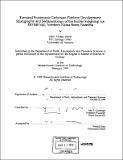Terminal proterozoic carbonate platform development : stratigraphy and sedimentology of the Kuibis Subgroup (ca. 550-548 Ma), Northern Nama Basin, Namibia.
Author(s)
Smith, Odin Alonso, 1973-
DownloadFull printable version (45.74Mb)
Advisor
John P. Grotzinger.
Terms of use
Metadata
Show full item recordAbstract
A stratigraphic and sedimentologic investigation of the Kuibis Subgroup, northern Nama Basin, was undertaken. An U-Pb zircon age determination on an intercalated volcanic ash directly constrains the age of the subgroup to be on the order of 550-548 Ma. The study involved logging eight sections which were measured and described in detail, spanning the region extending from Driedoornvlagte, located east of the Naukluft mountains, to Onis, at the southern edge of the Naukluft Mountains, then southward along the Namibian Escarpment to Zaris. The sections were correlated based on lithologic characteristics as well as sequence stratigraphic attributes. In addition, five of these sections were sampled at two- to five-meter intervals for ' 3C isotopic data, including two in the main study area (the adjoining farms of Donkergange and Zebra River), two southwards towards Zaris and one at Driedoornvlakte, which sits structurally beneath the Naukluft Nappes. Stratigraphic cross-sections constructed from the individual measured sections illustrate stratigraphic variability both across and perpendicular to depositional strike. The results of this study demonstrate that first-order stratigraphic patterns were fundamentally influenced by accommodation variations produced through differential subsidence related to tectonic loading along the edge of the Kalahari craton. The Kuibis carbonate platform developed as a ramp which was in part supplied by carbonate bioclastic debris generated by the earth's oldest calcified organisms. Fossil contents are highest in association with thrombolitic facies and suggest a strong substrate control on organism habitat. However, the bulk of the sediment may have been produced through aggregation of micrite, precipitated by abiotically or microbially-regulated processes, to form larger, sand-sized particles. As such, the Kuibis platform shares many characteristics in common with older Proterozoic carbonate ramps, but also some features more typical of Paleozoic ramps.
Description
Thesis (S.M.)--Massachusetts Institute of Technology, Dept. of Earth, Atmospheric, and Planetary Sciences, 1999. Includes bibliographical references (leaves 61-79).
Date issued
1999Department
Massachusetts Institute of Technology. Department of Earth, Atmospheric, and Planetary SciencesPublisher
Massachusetts Institute of Technology
Keywords
Earth, Atmospheric, and Planetary Sciences